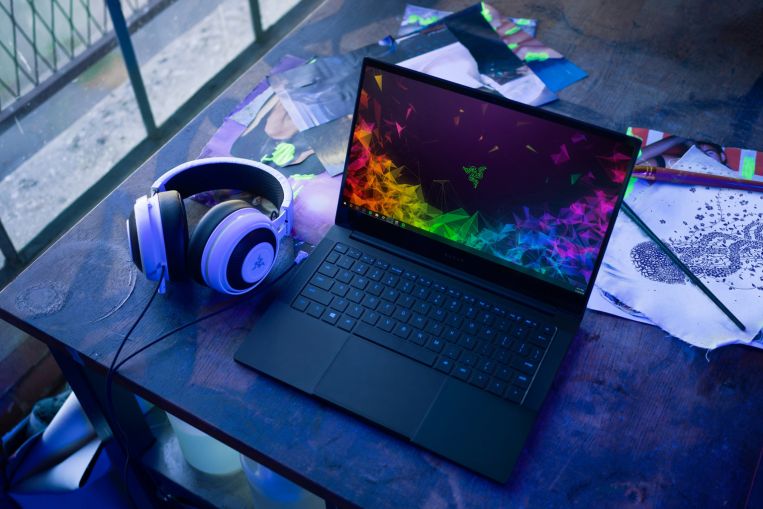Many gaming laptops aspire to be truly portable. But even the better ones, such as the Aftershock Vapor 15 Pro and the Razer Blade 15, are still relatively large 15-inch models that weigh around 2kg.
Razer, though, has managed to fit a gaming-grade Nvidia GeForce GTX 1650 Max-Q graphics chip in its new Blade Stealth 13 ultrabook. This svelte laptop weighs just 1.42kg and is only slightly thicker than its predecessor at around 15mm thick.
As expected from a Razer laptop, the build quality of the Stealth is exemplary. Its black unibody aluminium chassis feels solid without any flex. It feels very premium, down to the smooth, fluid motion of its hinge mechanism.
The best thing is its display. My review set has a 1,920 x 1,080-pixel screen, not the higher-end 4K touchscreen. But this in-plane switching display (IPS) looks great. Despite a matt finish to reduce reflections, the screen still looks vibrant and bright.
The display is surrounded by thin bezels on three sides, which creates an edge-to-edge look that feels modern and immersive.
Razer says this screen, which offers 100 per cent coverage of the sRGB colour space, is individually calibrated at the factory, which should help with colour accuracy.
Flanking the keyboard are stereo speakers that are surprisingly loud and clear, putting out enough volume to fill a bedroom.
The keyboard itself is unremarkable. It is shallow, which is expected from an ultrabook. However, it has a non-standard layout, featuring a tiny right Shift key that is separated from the question mark-cum-forward slash key by the Up arrow key.
If you often use the right Shift key to type a question mark, this layout will take some getting used to. Compounding the issue is that the arrow keys are the same size as the right Shift key instead of being half-height, so you cannot tell the position of the right Shift key by touch.
FOR
• First 13.3 laptop with gaming-grade graphics
• Bright and vibrant display
• Excellent build quality
AGAINST
• Pricey
• Non-standard keyboard
• Keyboard lacks per-key RGB customisation
SPECS
PRICE: $2,899
PROCESSOR: Intel Core i7-1065G7 (1.3GHz)
GRAPHICS: Nvidia GeForce GTX 1650 Max-Q 4GB GDDR5
RAM: 16GB DDR4
SCREEN SIZE: 13.3 inches, 1,920 x 1,080 pixels
CONNECTIVITY: Thunderbolt 3, USB 3.1 Gen 2 Type-C, 2 x USB 3.1 Type-A, audio jack
BATTERY: 53 watt-hour
RATING
FEATURES: 4.5/5
DESIGN: 4.5/5
PERFORMANCE: 3.5/5
VALUE FOR MONEY: 3.5/5
BATTERY LIFE: 3/5
OVERALL: 4/5
The Stealth also lacks per-key RGB backlighting – there is only single-zone backlighting, which feels limited compared with other modern gaming notebooks. The lighting effects can be adjusted in Razer’s Synapse 3 software.
That aside, the large Windows Precision trackpad is great. It is even bigger than the ones on some 15.6-inch laptops. It does not feel cramped and the palm rejection feature works a treat as there was no unwanted input when my palm was resting on it while typing.
Because of its fast – for an ultrabook – graphics chip, the Stealth can run the latest games decently. For instance, it produced 47 frames per second (fps) in Far Cry 5 and 42 fps in Shadow Of The Tomb Raider, at High setting and 1,920 x 1,080 pixels. The performance dips in a more demanding game like Metro Exodus, with the Stealth managing around 27 fps at High setting.
Heat and noise are important concerns for a gaming ultrabook. Thankfully, the Stealth was not that noisy even with its cooling fans set to maximum speed. The laptop felt warm above the keyboard, but the palm rest was comfortably cool.
But its battery life is not at the level of a typical ultrabook. In PCMark 10’s Modern Office battery test, the Stealth lasted 132 minutes – significantly shorter than the 523 minutes of the HP Spectre x360 ultrabook.
Overall, the Stealth feels like a truly portable gaming laptop with a premium design and a vibrant display, though it is not without its flaws.
Source: Read Full Article
